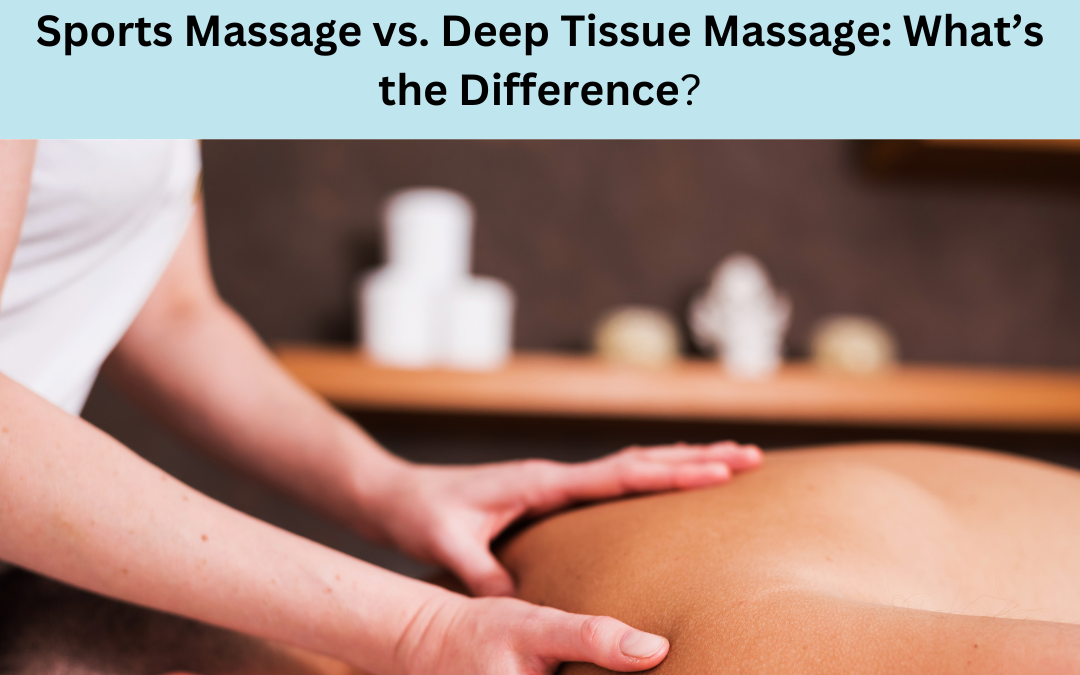When it comes to massage therapy, there are various techniques and modalities available to address different needs and concerns. Two popular types of massage therapy often sought after by athletes, active individuals, and those seeking therapeutic benefits are sports massage and deep tissue massage. While both these modalities have similarities, they serve different purposes and target specific areas of the body. In this blog post, we will explore the key differences between sports massage vs. deep tissue massage, their benefits, and how they can be beneficial for your overall well-being and performance.
I. Understanding Sports Massage Definition:
Sports massage is a specialized massage technique that focuses on treating athletes and individuals involved in sports and physical activities. It is designed to enhance athletic performance, prevent injuries, and aid in recovery.
Techniques and Goals: Sports massage therapists employ a range of techniques such as effleurage, petrissage, compression, stretching, and friction to target specific muscle groups and address issues related to athletic performance. The primary goals of sports massage include:
a. Pre-event Massage: This technique is performed before a sporting event to warm up muscles, increase flexibility, and enhance circulation, thereby preparing the body for optimal performance.
b. Post-event Massage: After an event, sports massage helps in reducing muscle soreness, promoting muscle recovery, and preventing the onset of delayed-onset muscle soreness (DOMS).
c. Maintenance Massage: Athletes often incorporate regular sports massages into their training routine to prevent injuries, improve flexibility, and enhance overall performance.
Benefits of Sports Massage: Sports massage offers several benefits, including:
a. Enhanced Performance: By improving blood circulation, flexibility, and range of motion, sports massage helps athletes perform at their best.
b. Injury Prevention: Sports massage aids in identifying and addressing imbalances, muscle tightness, and potential injury risks, helping athletes avoid injuries during training and competitions.
c. Faster Recovery: Through techniques like compression, stretching, and deep tissue work, sports massage facilitates the removal of metabolic waste products, reduces inflammation, and promotes faster muscle recovery.
d. Pain Relief: Sports massage can alleviate muscle tension, knots, and trigger points, providing relief from pain and discomfort associated with intense physical activity.
II. Exploring Deep Tissue Massage Definition:
Deep tissue massage is a therapeutic technique that targets the deeper layers of muscles and connective tissues. It aims to release chronic muscle tension, relieve pain, and improve overall flexibility and mobility.
Techniques and Goals: Deep tissue massage therapists use slow, firm strokes and deep pressure to reach the underlying muscles and fascia. The primary goals of deep tissue massage include:
a. Muscle Tension Release: Deep tissue massage targets adhesions, knots, and areas of chronic tension to alleviate pain and discomfort.
b. Improved Range of Motion: By addressing muscular imbalances and promoting flexibility, deep tissue massage helps individuals achieve better movement and range of motion.
c. Rehabilitation: Deep tissue massage is often recommended as part of a rehabilitation program to aid in recovering from injuries, such as sprains, strains, or muscle tears.
Benefits of Deep Tissue Massage: Deep tissue massage offers several benefits, including:
a. Pain Relief: By releasing tension and reducing inflammation, deep tissue massage helps in alleviating chronic pain conditions such as back pain, neck pain, and fibromyalgia.
b. Improved Posture: Deep tissue massage can help correct postural imbalances by releasing tension in specific muscle groups, promoting proper alignment.
c. Stress Reduction: Deep tissue massage promotes relaxation, reduces stress hormones, and encourages the release of endorphins, which can enhance mood and overall well-being.
d. Breakdown of Scar Tissue: Deep tissue massage can assist in breaking down scar tissue and adhesions, promoting better healing and mobility after injuries.
Conclusion:
While both sports massage and deep tissue massage offer numerous benefits, they are distinct in their techniques, goals, and targeted outcomes. Sports massage focuses on enhancing athletic performance, preventing injuries, and aiding in recovery for athletes and active individuals. On the other hand, deep tissue massage aims to release chronic muscle tension, alleviate pain, and improve flexibility and mobility for individuals seeking therapeutic relief.
If you are an athlete looking to improve your performance and prevent injuries, sports massage would be an excellent choice. However, if you are experiencing chronic muscle pain, limited range of motion, or seeking rehabilitation after an injury, deep tissue massage may be more suitable.
Regardless of your choice, it’s important to consult with a qualified massage therapist, such as those at Balancia Clinic (https://balancia.ca/), to determine the most appropriate treatment for your specific needs. A skilled massage therapist will assess your condition, discuss your goals, and tailor the massage technique accordingly to ensure optimal results.
Remember, whether you opt for sports massage vs. deep tissue massage, both modalities can significantly contribute to your overall well-being, physical performance, and quality of life. Take care of your body, prioritize self-care, and enjoy the benefits of massage therapy tailored to your unique needs and goals.

